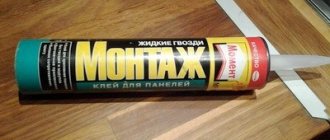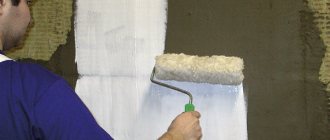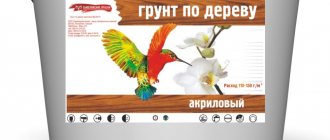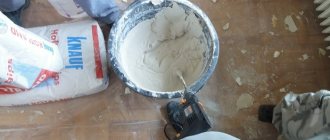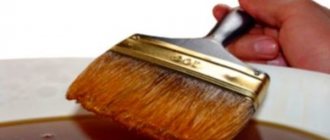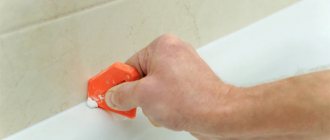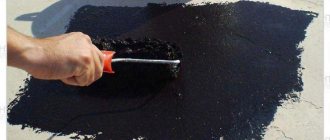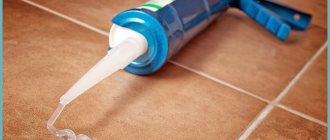In everyday life, silicone sealants are used to adhere to glass, ceramics, wood, PVC, porcelain, tiles and other surfaces.
The main advantage is water resistance and good adhesion to surfaces. And durability and plasticity guarantee convenient and high-quality use.
Silicone sanitary sealant Krass is one of the popular brands. Resistant to temperature extremes and mold, it reliably protects the surface on which it is used. Crass is suitable for both porous and smooth surfaces. It is reliable and has good grip on many surfaces. The transparent material looks aesthetically pleasing, is resistant to stains and does not contain harmful additives. Universal and indispensable for glass and wood surfaces.
Sanitary sealant Krass
What is silicone sealant?
Previously, various putties were used to remove seams, seal holes, cracks and other similar work. They had only a temporary effect, were quickly washed off, lost their aesthetic qualities, and the final result immediately after their use was not very pleasing. Today, silicone sealant is used for all these purposes. It allows you to create a durable, moisture-proof layer that lasts for many years, does not collapse, looks beautiful or even invisible. Important! Silicone sealant is a material for creating a durable, moisture-proof layer, insulating seams, gluing surfaces and sealing joints, which has good resistance to external influences
Silicone sealants - characteristics
It may seem strange, but elastic and soft silicone construction sealant is made from the strongest material - silicon, found in the form of quartz or sand. The polymers that make up silicone are made from it.
Based on this, there are a number of advantages, including:
- ability to stretch, which allows the use of silicone sealant on movable connecting areas;
- high degree of strength;
- excellent adhesion indicator - seals joints between elements made of ceramics, glass, wood, concrete, metal and plastic;
- resistance to ultraviolet radiation and aggressive detergent components;
- heat-resistant silicone sealant - retains protective characteristics over a wide temperature range (from -50° to +300°C);
- resistance to natural factors, allowing the sealant to be used both indoors and outdoors;
- does not react to the appearance of mold and bacteria.
Characteristics of sanitary silicone composition
Qualities:
- long service life - 15-20 years;
- versatility and aesthetics in use (transparent texture);
- absence of impurities, which gives better adhesion and environmental friendliness;
- ability to withstand temperature changes (-40 – +200˚) and high humidity in the bathroom;
Components:
- silicone rubber;
- material that increases flexibility - plasticizer;
- vulcanizer – transforms the composition of the product into a rubber-like mass;
- amplifier - for strength.
Transparent silicone compound
Types of silicone sealants by component composition
The component composition of silicone sealants is quite complex. During manufacturing, the following substances are added to it:
- silicone plasticizer - makes the material elastic;
- vulcanizer, which imparts viscosity to the material;
- silicone rubber (base);
- adhesion primer - ensures the adhesion of the material to the surface;
- amplifier – provides strength;
- filler that adds color.
All silicone sealants are divided into 2 main groups:
- single-component - often used in construction and repair;
- two-component - used in the industrial sector.
In turn, one-component silicone sealants, depending on the main component, are:
- Alkaline. Such sealants are included in the special-purpose group, and the main component is amines.
- Acidic. They are marked with the symbol “A” and belong to the group of universal silicone sealants, which have a low cost. During production, acetic acid is used as a basis, the smell of which can be felt when the mass hardens. The disadvantage of acidic silicone sealant is its incompatibility with most non-ferrous metals, as it causes an accelerated corrosion process. They are also not recommended for use with marble elements and with cement material containing alkaline particles.
- Neutral. An ideally neutral silicone sealant is compatible with surfaces made of any materials due to its component composition, which is based on ketoxime or alcohol.
When choosing a particular type of sealant, pay attention to the special additives used in the manufacture. There are 4 main types of additives:
- Dyes. Colored pigments are added to the composition during manufacturing, so the material does not become colored after drying.
- Mechanical fillers. Provide excellent adhesion of the silicone mass to the surface being treated.
Important! Mechanical additives include quartz dust or chalk.
- Extenders of natural origin - reduce the viscosity of silicone.
- Fungicides - help destroy mold and mildew.
Important! If you take into account the nature of the additive, you can significantly expand the scope of application of the sealant. Watch an interesting video review of silicone sealants to quickly understand which one you need.
About sealants
Carrying out construction, repair and assembly work requires solving a certain problem - how to effectively insulate cracks, seams, joints in various structures? The optimal solution is sealants. Viscous polymer compositions harden under the influence of moisture contained in the air. They have high adhesion to various types of surfaces and materials, provide excellent insulating characteristics, are elastic, and are resistant to many influences: low and high temperatures, precipitation and ultraviolet radiation, organic solvents. As a result, sealants are used in various fields . Certain types are used when installing plumbing equipment, laying communications and pipelines, installing doors and windows, eliminating leaks in roofs, sealing cracks, and repairing glass and porcelain products.
Transparent sanitary silicone sealant Soudal, 60 ml. Photo by Leroy Merlin
Manufacturers and suppliers offer a wide range of sealants , the variety of which is not easy to navigate. Sealants differ in composition and properties, and as a result, in areas of application. Some are best suited for humid environments, others for outdoor use, others for use at high temperatures, etc. To better understand the features and characteristics, there are several classifications.
In accordance with the polymer, which is the basis of the composition, several types are distinguished, including silicone sealants, which are classified into separate groups according to their intended purpose . Sanitary sealant is especially in demand when performing work in the kitchen and bathroom, as well as other rooms with high levels of humidity, where there is a high risk of mold and mildew formation.
Sanitary compounds, in turn, are also divided into acidic and neutral . The former are common in everyday life, as they are sold everywhere and at reasonable prices. Their disadvantage is that they cannot be used for sealing metal surfaces; they are also not recommended for cement products. Contact may cause undesirable reactions, such as premature corrosion. The best option for sanitary sealant is neutral , as it is universal and suitable for various surfaces.
The compositions are chemically inert and do not react with the treated surfaces and the environment.
Brands and remarks: which manufacturer to trust
When choosing and purchasing silicone sealant, you should adhere to the rule: a high-quality product cannot be cheap. As mentioned above, unscrupulous manufacturers are cunning and offer low prices due to the same low quality. Of course, trusted brands also have defective batches, but their share is extremely small.
Basically, low quality is assumed from the very beginning - a large percentage of foreign impurities proportionally worsens the quality of silicone: elasticity and strength decrease, resistance to aggressive influences decreases, color changes, and curing is impaired.
When choosing a quality product, you need to pay attention to the following factors:
- Manufacturer - there are quite a few proven brands: “Macroflex”, “Soudal”, “Moment”, “Econ”, “Kvadro”.
- Original branded packaging with all the information (quality indicators and composition).
- Availability of certified copies of certificates from the seller.
You should be wary of the product:
- With a large weight (more than 340 grams with a volume of 310 ml).
- Labeled “100% silicone” - not a single manufacturer uses silicone in its pure form, without additives or plasticizers.
- With a very low price (the production technology is such that the cost of one tube of sealant costs approximately 70–90 rubles. Add to this amount the average trade margins of 20–50% and you will see the real price of a quality product).
- With a worn and especially paper label.
Types of sealants and their scope of application
Sealants can be divided into 2 main classes:
One-component silicone sealants are sold in auto and hardware stores in packages for independent use at home. Can be used immediately and do not require connection with additional materials. Polymerizes under the influence of atmospheric humidity. One-component household sealants according to their chemical composition can be:
- Acidic sealants have a strong chemical odor. Not suitable for cement and metal surfaces.
Acidic materials can cause allergies and burn the mucous membranes. Therefore, when working with them you need to use respirators, safety glasses and gloves.
- Neutral sealants cost 30–40% more and have a wider range of applications.
Two-part silicones are available in large volume packages. They are used for industrial purposes. Additional reagents are used for polymerization.
Scope of use of silicone compounds:
- Installation of equipment for bathrooms, showers, kitchen basins and other rooms with high humidity.
- Restoration and installation of external cladding of buildings.
- Repair, installation, insulation of electrical equipment.
- Installation of automotive components and assemblies.
- Sealing of aquarium systems.
- Installation and fixation of glass structures.
What are they used for?
1) Sanitary neutral silicone is used to solve a wide range of problems:
- sealing:
* bathtubs, shower cabins and trays, including acrylic and PVC; * kitchen sinks and countertops made of natural stone and conglomerates; * various seams in rooms with high humidity: bathrooms, kitchens, laundries, refrigeration rooms; * ventilation systems; * and glass connections in the production of windows;
- filling seams in partitions;
- performing urgent glass work;
- elastic joints resistant to precipitation, for example, seams on facades.
Attention. Do not use on natural stones: marble, granite and others. For these works it is necessary to use Soudal Silirub MA.
2) and 3) Acid sanitary silicones are used to perform the following work:
- sealing:
* sinks, bathtubs and enamel shower trays; * gaps between the sink and the wall, around sinks and ceramic bases; * connections in air conditioning systems;
- construction and construction seams;
- filling the seams of ceramic tiles between walls and floors;
- elastic seals in rooms with high humidity: kitchens, bathrooms and laundries;
- connections in kitchens, bathrooms and refrigeration rooms;
- performing urgent glass work.
Attention!
1) Due to their acidic nature, the compositions can interact with some metals: lead and copper. 2) Do not use on stones such as marble, granite and others, as the sealant may leave stains. In such cases, it is recommended to use Soudal Silirub MA.
The absence of ultraviolet radiation can lead to discoloration of the seam.
Rating of the best
Today there are more than 200 brands of silicone sealants. Not all of them meet the stated characteristics.
In order not to be mistaken in quality, we offer a list of manufacturers and brands of adhesives that have long proven themselves:
MAKROFLEX NX108
Transparent silicone sealant MAKROFLEX NX108 is a one-component waterproof composition. Has the widest range of uses. It is used for fixing and sealing joints of elements in bathrooms, saunas, swimming pools, and sealing cracks. With its help, installation and repair of refrigerator and freezer units, repair of ships (motor boats, yachts) and automobile units are carried out. Sealing of window and door openings.
Produced in Russia using Finnish technology. Application temperature from 7 to 45 ˚C. Wide operating temperature range from -38 to +140 ˚C. Setting time 15 minutes, until complete drying 48 hours. The neutral chemical composition does not cause corrosive changes in the material. Packaging: a convenient tube with a cone dispenser. Package price 290 gr. – from 280 rub.
Moment Silicone neutral
Moment Silicone neutral – gray one-component adhesive. High-quality and reliable domestic composition. Used for installing mirrors, glass, ceramic, sanitary ware in bathrooms, showers, and lavatories. Suitable for repairing refrigeration and ventilation systems, watercraft, and automotive components. Not recommended for working with natural stone and aquarium equipment.
Application temperature from 7 to 40˚C. Operating range from -38 to +140˚С. Setting time 15–20 minutes. Does not stain mating surfaces. Time until complete curing is 48 hours. Resistant to UV rays. Available in a tube with a 280 g dispenser, package price starts from 280 rubles.
CERESIT CS 24
Universal silicone sealant CERESIT CS 24 is an acidic one-component adhesive. Designed for processing the perimeter of door and window openings, shop windows, double-glazed windows, colorless. Resistant to the formation of fungal and mold deposits. Can be used for exterior work without primer.
Produced in Russia using German technology. Not for use on surfaces made of zinc, copper, iron, marble, limestone. Application temperature from 10 to 35˚C. Operating range from -40 to +120˚C. Curing time 20 minutes, until complete setting 48 hours. Price per package (tube with dispenser) 280 g. from 220 rub.
Liqui Moly "Silicon-Dichtmasse"
Black silicone sealant Liqui Moly “Silicon-Dichtmasse”. German brand Liqui Moly, specializing in the production of automotive oils and lubricants. A one-component, high-temperature composition, which, upon polymerization, forms sealing connections between elements made of glass, wood, plastic, and porcelain. It is used for repair and maintenance of automobile components, watercraft, installation and gluing of glass parts.
Resistant to vibration loads. Application temperature from 5 to 40˚C. Operating range from -60 to +300˚C. Film formation time is 8–12 minutes, until complete drying 24 hours. Price for 80 ml packaging. from 500 rub.
Ravak Professional X01201
Ravak Professional X01201 is a transparent sealant from the Czech manufacturer of plumbing fixtures of the same name. It is designed for sealing plumbing fixtures and lining materials in bathtubs and showers. Retains antifungal properties for a long time. Reliably fixes aluminum, acrylic, glass, stone, ceramics, varnish. Non-toxic, does not change color over time.
Temperature for installation is from 10 to 40˚C. Operating range from -20 to +120˚C. Curing time 20 minutes, until complete adhesion 48 hours. Sold in tubes with a 310 ml dispenser. Package price from 720 rub.
How to apply silicone sealant
Let's look at the step-by-step process of how to use sealant. Let's take silicone Moment sealant as an example:
1. Before starting work, put on overalls, be sure to use protective gloves so that the material does not get on the skin of your hands.
2. Wipe the surface from dust, degrease and dry it. Cover the decorative surface with masking tape to avoid contact with the silicone compound.
3. It is more convenient to apply silicone moment using a mounting gun. How to install it is usually written on the packaging of the sealant itself.
4. Cut the edge of the cartridge at an oblique; this section will allow the sealant to flow evenly.
5. Apply silicone, holding the sealant at a 45° angle. Try to make each strip thin, so the material will dry faster. For complete adhesion, connect both sides. Remove excess material with a spatula.
As for drying, everything will depend on the type of sealant, as well as the thickness of the applied layer. On average, the material hardens in about 24 hours; a hard film appears on the surface after the first 20 minutes.
To make the edges of fiberboard and chipboard products durable and water-resistant, apply a thin layer of instant sealant using a rubber spatula. But if you want the surface to be perfectly smooth, you can dilute the silicone sealant with gasoline or a small amount of white spirit. Moreover, after complete drying, it will not lose its heat-resistant and water-resistant qualities.
An exact description of the use of silicone sealant can be found on the packaging. As a rule, it indicates what the material is used for, how to apply it to the surface, its complete drying time, and expiration date. You should not purchase adhesive-sealant at a promotional price that has expired. This material loses its properties and should not be used during repair work.
Silicone sealants: types and applications
Sealants are medium-density masses that can easily be used to fill a crack, scratch or expansion joint. Easy because they are pressed out of the plastic cartridge using a hand gun.
Silicone caulk is a fairly broad term that gets thrown around a lot, especially when it comes to DIY projects. Most people's first thought is to go to the local DIY store and buy the cheapest one in the right color.
However, there is really no one type of silicone caulk that can be used for everything. There are many different types that have different flexibility, strength and resistance. So how do you know you're using the right one for the job?
Silicone caulk is generally classified based on what job it is suitable for, making choosing the right product very easy.
At its core, a sealant is a viscous fluid or paste-like substance made on the basis of oligomers or polymers. Its purpose is waterproofing and sealing. Sealing compounds can harden after application to the work surface and do not dry out.
Application of silicone sealants
- Sealing gaps around bathtubs, showers, windows, work surfaces.
- Attaching mirrors or glass to tiled surfaces.
- Sealing gutters and downpipes.
- Repair of rubber linings on cars.
- Molding of soft rubber products of any shape.
- Production of reusable flexible forms.
- We glue aquariums together.
Silicone sealants are used in a wide variety of construction applications due to their high performance properties, including:
- UV resistance.
- Heat resistance.
- Maximum mobility (class 50–100).
- Typically longer lifespan.
- Continued flexibility over time.
Sealing joints is the task of silicone
The most important part of any bathroom are the connections in corners and transitions made of various materials, including where plumbing fixtures are installed. Silicone sealants are designed to fill cracks and crevices.
Such a finished surface will become more airtight, which is especially important in the case of places that are constantly in contact with water - washbasin, bathtub, shower tray, toilet. Water cannot get into the base, which protects our bathroom from mold and mildew.
Advantages and disadvantages
If we consider silicone sealant as a tool that is now difficult to do without in repairs of varying complexity, then it is necessary to indicate all its advantages and disadvantages.
Let's consider the advantages of sealant.
- Prevents the formation of mold and the spread of insects on the surface. This becomes possible thanks to the fungicidal additives that are included in its composition.
- After complete drying, it is not afraid of exposure to cleaning agents, even chemical ones.
- Using a sealant, it will be possible to bond different types of surfaces. For joining ceramics, glass, plastic, wood, rubber with other materials, silicone is the best choice.
- High strength of the material after drying, even with a liquid and elastic structure during application. This is achieved by the presence of silicon in the composition.
- The peculiar composition allows the already glued surfaces to be movable and elastic.
Despite such a large number of advantages, there are also significant disadvantages to silicone sealant.
- There are a number of surfaces that do not bond well with sealant - these are polyvinyl chloride, fluoroplastic, polyethylene, polycarbonate and polypropylene.
- For application, the surface must be completely clean, so it is cleaned, degreased and completely dried. When applied to a damp surface, the properties of the material deteriorate significantly.
Acrylic and silicone sealant have some differences, and first of all, their difference is in composition: for silicone glue, rubber is an important component in the composition, but for acrylic it is acrylic acid. Silicone sealants are used to work with plastic, wood and ceramics, and the acrylic variety is universal. When working with the acrylic version, you can sand it to get a completely smooth surface that can be painted. However, here there is a stronger shrinkage and, when frozen, the material is not so elastic. This type is used for interior work, because with a large amplitude of temperature conditions it can deteriorate.
Silicone sealant provides better adhesion to even and smooth surfaces; it is not afraid of compression and kinks. Because of this, the cost of this option is more expensive than acrylic. Both types of materials can be either transparent or colored, which are used in various situations.
Since silicone sealants can be one-component or two-component, it is important to understand the differences in this case, identifying the specific advantages and disadvantages of each option. The one-component composition is the most common; it is used for all construction work by both professionals and amateurs. The ease of working with it determines the popularity of this material. The scope of use of sealants is constantly expanding. So, it can be used not only in home repairs, it is also very useful for working with a car, eliminating any seams, cracks and joints, it can be used to insulate electrical equipment, and in some cases it is used as a protective layer from moisture.
Two-component silicone is used in production and industry. The composition is much more complex, because it combines various elements. It is not used for everyday repair tasks.
Application
When using the sanitary product, be careful not to spoil the appearance of the product. When applying the composition in the bathroom, first thoroughly dry and degrease the area to which you are applying the composition. This material will not adhere to a wet area.
Before using it in the bathroom, the end of the tube is cut at an angle of 45˚ and a special tip is put on. After this, the tube is inserted into the mounting gun and the product is squeezed out with its help.
To make a beautiful seam, adjust the pressure on the gun. To get an even seam, cover the edges of the seam with protective tape or tape. This is necessary in order to protect the surface from excess foam, since it is quite difficult to remove it later.
Tube gun
Excess sanitary composition is removed from the surface using a damp sponge or cloth. A small spatula will do, and if you soak it in solvent, it will be easier to remove the excess. After 5-10 minutes, trim the seam; this can be done with a spatula or just your finger.
The foam will dry in 8 hours. Work with it at a temperature not lower than +20 ˚С, but if the thermometer shows below +5 ˚С, make sure that there is no condensation on the surface being treated.
Sanitary sealant is suitable for the bathroom, as it prevents the formation of fungus and mold. After use, you don't have to worry about moisture penetration.
Consumption
In order for the repair to be done efficiently and all seams and joints to be sealed beautifully and reliably, it is important to know exactly how it needs to be applied and how much material to use. When calculating the most correct consumption of sealant per 1 m of seam, you need to know its thickness and application technology. If we are talking about a corner seam between the bathtub and the tiles, then the best would be a depth of 6 mm and a width of 3 mm. Using such calculations, 20 ml of material will need to be used per meter of area. Often the standard package contains 310 ml, and in order to apply it correctly and economically, it is best to be guided by the indicators given in the table:
| Seam width in mm | |||||||
| Seam depth in mm | 5 | 7 | 10 | 12 | 15 | 20 | 25 |
| 5 | 12 | 8 | 6 | — | — | — | — |
| 7 | — | 6 | 4 | 3 | — | — | — |
| 10 | — | — | 3 | 2.5 | 2 | 1.5 | — |
| 12 | — | — | — | 2.1 | 1.7 | 1.2 | 1 |
| 15 | — | — | — | — | 1.3 | 1 | 0.8 |
If a 600 ml bag was chosen for the work, then the calculations will be different for 1 m of seam:
| Seam width | |||||||
| Seam depth | 5 | 7 | 10 | 12 | 15 | 20 | 25 |
| 5 | 23 | 15 | 11 | — | — | — | — |
| 7 | — | 11 | 7 | 6 | — | — | — |
| 10 | — | — | 6 | 5 | 4 | 3 | — |
| 12 | — | — | — | 4 | 3 | 2.4 | 2 |
| 15 | — | — | — | — | 2.5 | 1.9 | 1.4 |
For a more economical use of sealant, it is better to apply a semicircular seam, which is possible when working with a spatula having an edge of 6 mm; in addition, it is very important to correctly trim the nose of the tube itself, from where the material will come. To do this, you need to attach the spatula to the spout at an angle of forty-five degrees and open the package.
How long does silicone sealant take to dry?
From the moment of application until the film appears, about 20 minutes pass. Full curing time takes 24 hours.
In some cases, the duration of complete drying depends on:
- thickness of the layer applied per linear meter;
Important! When applying a strip of material with a cross-section of 4x3 mm, a 300 ml tube of sealant will be enough for 17-18 linear meters.
- component composition;
- mass density;
- purpose.
Important! Complete hardening of some types ranges from 1 to 3 hours.
How long does it take to dry, drying time
The formation of a surface film occurs within 9 and 20 minutes for the first, second, and third variants of sealants. Curing time is 24 hours . But it should be remembered that the parameters may differ depending on temperature, humidity and surface type. The presented indicators are achieved under certain conditions : in the first case it is +23 degrees Celsius and 50% relative humidity, for the second and third options of sanitary silicones it is +20 degrees and 65% relative humidity.
